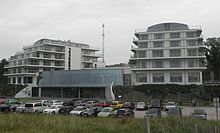Kurhaus Ahrenshoop
The Kurhaus Ahrenshoop was a hotel in Ahrenshoop , Amt Darß / Fischland , Mecklenburg-Western Pomerania .
The first spa house in 1891
| The first Kurhaus around 1920 on a postcard |
|
Link to the picture |
The origins of the Kurhaus Ahrenshoop are in 1891. At that time acquired the Rostock entrepreneur Carl Molchin surfaces in Ahrenshoop and built until 1893 that after Duke Bogislaw IV. Of Pomeranian named Kurhaus Bogislaw which quickly becoming the focal point of society for its artists' colony known Place Ahrenshoop developed.
In 1911 a Miss von Walsleben bought the property. In 1912 she built Cafe Bogislaw next to Kurhaus Bogislaw . In 1919 the Kurhaus changed hands again, von Walsleben sold it to the Ribnitz town councilor. D. Falkenberg and the Krefeld entrepreneur Oetker, but remained the owner of the neighboring café. There was a name dispute between von Walsleben and the new owners about the name Bogislaw . In consequence of which was Kurhaus Bogislaw from 1920 in Kurhaus renamed. A new typography was specially designed for the hotel's logo, which is still used today in a modified form.
In the course of Aktion Rose , the Kurhaus was nationalized in 1953 and operated under the name “Kurhotel” by the FDGB Feriendienst Rostock. A year later it was taken over by the GDR Ministry of Culture .
The second Kurhaus in 1968
In 1968 the old Kurhaus was closed and torn down to make room for a new building. On July 18, 1970, the right-angled, strict-looking new building of the Kurhaus, for which the old building fabric had been used in part, was opened. The large glass front of the dining room with a view of the Baltic Sea shaped the external appearance of the building, the modern kitchen and the furnishings of the 21 rooms corresponded to the zeitgeist of the time. The glazed dining room of the Kurhaus earned the hotel the nickname “Bonzenaquarium”.
In 1975 the spa business with 90 employees was taken over by the new hotel manager Horst Mertinat. Despite low restaurant prices, Mertinat managed to develop the Kurhaus into a profitable facility with an average daily turnover of 8,000 marks . In particular, the summer night balls and the culinary national events were very popular with the guests, so that the events were quickly sold out even in advance sales.
With the change came the end of the Kurhaus, which in 1990 was the only hotel in Ahrenshoop. Accompanied by layoffs, the business continued until it was liquidated by the Treuhandanstalt in autumn 1993. After that, the building on the Schifferberg lost its original purpose as a hostel and fell into disrepair in the 1990s.
During this time, the house only gained fame as a backdrop for cultural events. In February 2008 the Berlin artist Philipp Geist (* 1976) staged part of his exhibition Times and Spaces in the Ruin with the video installation time lines . He renounced the use of screens and projected directly from the inside onto the window front of the Kurhaus. In doing so, Geist primarily focused on the interplay between the dilapidated fabric of the building and his abstract, geometric video works.
Replacement building in 2010
After years of dilapidation, the last dilapidated Kurhaus was demolished in 2008 and, after a two-year construction period, a replacement building was reopened as the Grand Hotel & Spa Kurhaus Moderne in 2010 . The hotel name has been changed several times with the changing manager and owner.
In 2013 the hotel was the location of the Mumblecore film Love Steaks .
In 2016 was in the construction of the new documentary film Five Star from Anne Katrin Hendel . In the documentary, Hendel deals intensively with her friend, the photographer Ines Rastig , who is suffering from lung cancer while they are on vacation in the Baltic Sea . The film was shown for the first time in February 2017 at the 67th Berlinale as part of the Panorama Documents section. Ines Rastig died four months after the film was shot in January 2016. During her stay, Ines Rastig made many unusual works and self-portraits. Part of her work was exhibited in the hotel in September 2016.
Web links
- Literature about Kurhaus Ahrenshoop in the state bibliography MV
- Kurhaus Ahrenshoop in the Darss Lexicon
- Kurhaus Ahrenshoop in ahrenshoop-digital.de
Individual evidence
- ↑ a b c d History of the Kurhaus ( Memento from August 21, 2017 in the Internet Archive ), Lupcom Media, accessed on February 21, 2018.
- ↑ a b c history of the Kurhaus , the-grand.de, accessed on March 8, 2018.
- ^ Hotel Namenlos , accessed on February 22, 2018.
- ↑ Bernd Schiller: Art and enjoyment under the thatched roof , Abendblatt.de, August 24, 2010, accessed on February 22, 2018.
- ↑ Michael Pasdzior: Thatched Roof House on an Old Dune , Abendblatt.de, June 14, 2003, accessed on February 22, 2018.
- ↑ Daniela Lange: On the trail of the artists' colony Ahrenshoop . ISBN 3-8370-2929-8 , p. 78.
- ↑ Martin Ahrends: It was such a beautiful summer , zeitonline, September 19, 2015, accessed on February 21, 2018.
- ↑ “We can't stand it” , Der Spiegel , April 9, 1990, accessed on February 21, 2018.
- ↑ spirit Installation Kurhaus , videogeist.de, accessed on February 22 2018th
- ↑ Bernd Matthies: From table to table - Hotel Kurhaus ( Memento of the original from February 22, 2018 in the Internet Archive ) Info: The archive link was inserted automatically and has not yet been checked. Please check the original and archive link according to the instructions and then remove this notice. , Tagesspiegel.de, February 24, 2013, accessed on February 21, 2018.
- ↑ Five stars on www.moviepilot.de.
- ^ Press booklet for the film Five Stars
Coordinates: 54 ° 23 ′ 2.5 ″ N , 12 ° 25 ′ 31.8 ″ E


